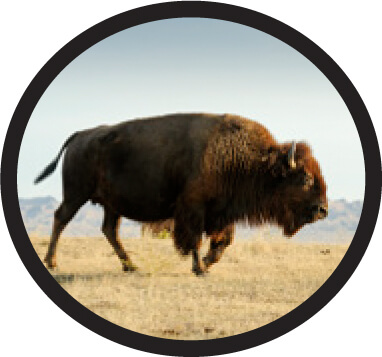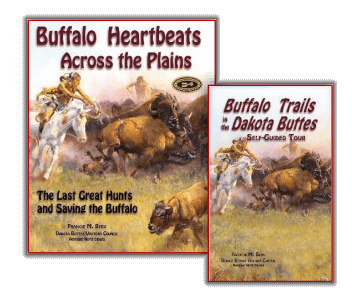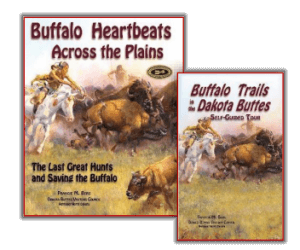

Blog List
Join Us in Celebrating National Bison Day!
by Francie M. Berg | Nov 1, 2022
First, we have a buffalo story that you can tell your children and friends to celebrate National Bison Day!
Traditional storytellers believe that old stories are best told in the Native language and to listeners who understand their culture.
They say an amusing story is “not as funny” in English. Much of the spirit, humor and excitement gets lost in translation.
Stories of Origin
by Francie M. Berg | Oct 18, 2022
The buffalo is celebrated as sacred by the Plains Indians in stories, songs, dances, artwork and religious symbols and ceremonials.
For thousands of years buffalo were intimately connected with the Indian culture, both physically and spiritually.
Buffalo Stories of the Northern Plains
by Francie M. Berg | Oct 4, 2022
Part 3-American Indians of North Dakota (4th grade)
by Francie M. Berg | Sep 20, 2022
Part 2-American Indians of North Dakota (4th Grade)
by Francie M. Berg | Sep 6, 2022
About 2,500 years ago, the people of the Woodland era appeared in North Dakota. These people came from the forests of Minnesota and Wisconsin.
The Woodland people hunted and gathered as the earlier groups had done and they got corn through trade. The Woodland people were the first people in North Dakota to make pottery.
American Indians of North Dakota—Part 1 (4th grade)
by Francie M. Berg | Aug 23, 2022
North Dakota Studies at the State Historical Society of ND has recently revamped its units on “American Indians of North Dakota.” Well done!!
We plan to cover the highlights of this topic during the next year—especially for our American History teachers–first with grades 4 and 8 in ND and then adding information from other states. We won’t give you the entire load at once—but probably will keep feeding it out as we go through the year.
The Incredible Shrinking Buffalo
by Gene Gade | Aug 10, 2022
BSC Bison Symposium, June 22-25, 2022, Part 2
by Francie M. Berg | Jul 26, 2022
On Friday afternoon, June 24, 2022, the two buses on tour for the BSC Dakota Bison Symposium continued by visiting the Johnson buffalo herd. Jim Strand—manager and herdsman—circles the herd with his feed wagon and the buffalo come running. Photo Credit Kathy Berg Walsh.
BSC Bison Symposium-June 22-25, 2022
by Francie M. Berg | Jul 12, 2022
The BSC Dakota Bison Symposium kicked off with a pre-conference evening meal in the 4th floor showplace in the Energy Building for invited speakers—some just flying in—committee members and bus hosts on Wed evening June 22, 2022. The 4th floor dining room provides guests a spectacular view of the blue Missouri River rolling away toward the southeast through this great valley of big old cottonwood trees. We can see two bridges plus the old Northern Pacific railroad bridge barely discernable through the gnarly cottonwood trees at the far right. Photo credit Francie M Berg.
Vore Buffalo Jump—Part 2
by Francie M. Berg | Jun 28, 2022
The Vore Buffalo Jump—Part 1
by Francie M. Berg | Jun 14, 2022
Vore Buffalo Jump in northeastern Wyoming does not involve a cliff at all, but rather, a trap.
It developed when a sinkhole opened up at the western edge of the Black Hills cave system and was used as a jump to trap bison by Native American hunters for about 250 years.
When the hole was first used some 450 years ago, it was 75 feet deep and narrower than now. Today, it is about 50 feet deep and more than 200 feet across.
Body Condition Scoring Guide for Bison
by Francie M. Berg | May 31, 2022
Canada has developed detailed national guidelines or Codes for the care and handling of farm animals, including bison and poultry. The Codes serve as the national understanding of animal care requirements and recommended practices.
The writers of these codes come together from a wide background of experience in studying and handling specific animals. They meet together and make decisions on what Canadian recommendations should be for each species.
Teachers: Do you remember what you did last summer?
by Francie M. Berg | May 17, 2022
New Threat to Buffalo—Mycoplasma bovis
by Francie M. Berg | May 3, 2022
A recent New York Times article by Mitch Smith describes the disaster that has come to one Native American rancher in South Dakota who has worked 30 years to build up his buffalo herd.
He reported that Fred DuBray’s bison herd on the Cheyenne River Reservation has been ravaged by Mycoplasma bovis, a tiny bacterium that is decimating herds across the Plains and the West. Smith’s report He Spent Decades Protecting Buffalo; A Microscopic Invader Threatens That Work appears in the March 12, 2022 issue of the Times.
Since last year, his buffalo have been dying by the dozens, victims of a microscopic invader, Mycoplasma bovis, that has ravaged pastures across the Great Plains and the West, according to Smith.
Part 2—Crossbreeding Buffalo in Canada
by Francie M. Berg | Apr 19, 2022
Have you been thinking of crossbreeding some of your bison with beef cattle?
That has sounded like a good idea to lots of honest men and women for more than a century. If we can bring about in one animal: the best of both buffalo and cattle—that would be great, wouldn’t it?
How about having that sound intelligence and hardiness of American bison for every storm that comes along—evolved and adapted through thousands of years—to live in the far north?
And then mix in the abundance of great beef—not just what the slim-hipped buffalo provides, but real abundance in length and breadth of that tasty, tender loin and hip: mmmm.
Your beefalo—or catalo—or whatever you choose to call them—would certainly retain the best traits of both species, wouldn’t they?
Every few years it seems like some promoter is trying to sell that idea. Sounds like a good one, Right? Have you ever been tempted?
What is Birth Synchrony in American Bison?
by Francie M. Berg | Apr 5, 2022
Saving Orphan Buffalo Calves
by Francie M. Berg | Mar 22, 2022
Feeding an orphan calf is an emergency situation. It has to be done “right now!” And it is a time commitment.
So it’s a good idea to be prepared.
Calving season has arrived and so have many new buffalo babies. It’s an exciting time of the year when new calves are welcomed to the world.
Fortunately for you who are buffalo ranchers there are usually few problems associated with calving.
Bison of Yellowstone Park and Brucellosis
by Francie M. Berg | Mar 8, 2022
Part2-Yellowstone Park in Winter
by Francie M. Berg | Feb 22, 2022
Visiting Yellowstone Park in Winter-Part 1
by Francie M. Berg | Feb 8, 2022
Canadian Bison Discover Ancient Petroglyphs
by Francie M. Berg | Jan 25, 2022
Can you Find Buffalo Trails where You Live?
by Francie M. Berg | Jan 14, 2022
We know that thousands of buffalo roamed across the face of the Great Plains in ancient times.
Where we live, in the northern plains of western North Dakota, they’ve been hunted for at least the past 7000 years—and likely grazed here for many more thousands before humans arrived.
Seasons Greetings
by Francie M. Berg | Dec 28, 2021
Crossbreeding Buffalo in U.S.—Part 1
by Francie M. Berg | Dec 14, 2021
Buffalo Stampedes
by Francie M. Berg | Nov 30, 2021
Bison Sounds and Vocalization
by Francie M. Berg | Nov 14, 2021
The Trophy was the Journey
by Guest Editor J. Russell Nielson, Salt Lake City and Manti | Nov 2, 2021
The Legacy of Wind Cave National Park
by Francie M. Berg | Oct 19, 2021
Why not celebrate this year’s National Buffalo Day by telling a favorite buffalo story?
by Francie M. Berg | Oct 5, 2021
National Bison Day, November 6, 2021, is an annual event. It falls on the first Saturday in November each year. Americans are encouraged to reflect on the impact Bison have as a part of our environmental and cultural heritage.
Wainwright’s Buffalo Legacy
by Francie M. Berg | Sep 21, 2021
Wainwright, Alberta, is a midsized town in the Canadian Great Plains with a tumultuous buffalo legacy. It lies east of the Rocky Mountains just west a few miles from the Saskatchewan border and to the northeast of Calgary.

Author
Francie Berg

Assistant
Ronda Fink
Subscribe
Sign up today for your
FREE Subscription
to the
Buffalo Tales & Trails
blog.
Click Here


